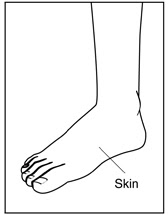Diabetes can hurt your clamber in two ways:
If your blood glucose is high, your body loses fluid. With less fluid in your body, your skin can get dry. Dry skin can be itchy, causing you to abrasion and make it sore. Cracks allow germs to enter and cause infection. If your blood glucose is high, it feeds germs and makes infections worse. You may get dry skin on your legs, elbows, feet, and other places on your body.
Nerve cause can decrease the amount you sweat. Sweating helps keep your skin soft and damp. Decreased sweating in your feet and legs can cause dry skin.
What can I do to take care of my skin?
If your blood glucose is high, your body loses fluid. With less fluid in your body, your skin can get dry. Dry skin can be itchy, causing you to abrasion and make it sore. Cracks allow germs to enter and cause infection. If your blood glucose is high, it feeds germs and makes infections worse. You may get dry skin on your legs, elbows, feet, and other places on your body.
Nerve cause can decrease the amount you sweat. Sweating helps keep your skin soft and damp. Decreased sweating in your feet and legs can cause dry skin.
What can I do to take care of my skin?
- After you endure with a mild soap, make sure you rinse and dry yourself well. Check places where water can hide, such as under the arms, under the breasts, between the legs, and between the toes.
- Keep your skin moist by using a lotion or cream after you wash. Ask your doctor to suggest one.
- Drink lots of fluids, such as water, to keep your skin moist and healthy.
- Wear all-cotton underwear. Cotton allows air to move around your body better.
- Check your skin after you wash. Make sure you have no dry, red, or sore spots that might lead to an infection. Tell your doctor about any skin problems.













